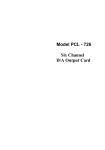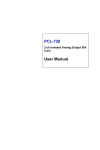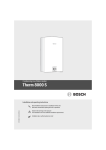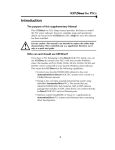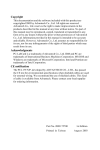Download PCL-726 User Manual
Transcript
PCL-726 6-ch Analog Output ISA Card with 32-ch DI/O User Manual Copyright The documentation and the software included with this product are copyrighted 2011 by Advantech Co., Ltd. All rights are reserved. Advantech Co., Ltd. reserves the right to make improvements in the products described in this manual at any time without notice. No part of this manual may be reproduced, copied, translated or transmitted in any form or by any means without the prior written permission of Advantech Co., Ltd. Information provided in this manual is intended to be accurate and reliable. However, Advantech Co., Ltd. assumes no responsibility for its use, nor for any infringements of the rights of third parties, which may result from its use. Acknowledgements PC-LabCard is a trademark of Advantech Co., Ltd. IBM, PC are trademarks of International Business Machines Corporation. MS-DOS, Windows, Microsoft Visual C++ and Visual BASIC are trademarks of Microsoft Corporation. Intel and Pentium are trademarks of Intel Corporation. Delphi and C++ Builder are trademarks of Borland Corporation. Part No. 2003726000 1st Edition Printed in Taiwan November 2011 PCL-726 User Manual ii Product Warranty (2 years) Advantech warrants to you, the original purchaser, that each of its products will be free from defects in materials and workmanship for two years from the date of purchase. This warranty does not apply to any products which have been repaired or altered by persons other than repair personnel authorized by Advantech, or which have been subject to misuse, abuse, accident or improper installation. Advantech assumes no liability under the terms of this warranty as a consequence of such events. Because of Advantech’s high quality-control standards and rigorous testing, most of our customers never need to use our repair service. If an Advantech product is defective, it will be repaired or replaced at no charge during the warranty period. For out-of-warranty repairs, you will be billed according to the cost of replacement materials, service time and freight. Please consult your dealer for more details. If you think you have a defective product, follow these steps: 1. Collect all the information about the problem encountered. (For example, CPU speed, Advantech products used, other hardware and software used, etc.) Note anything abnormal and list any onscreen messages you get when the problem occurs. 2. Call your dealer and describe the problem. Please have your manual, product, and any helpful information readily available. 3. If your product is diagnosed as defective, obtain an RMA (return merchandize authorization) number from your dealer. This allows us to process your return more quickly. 4. Carefully pack the defective product, a fully-completed Repair and Replacement Order Card and a photocopy proof of purchase date (such as your sales receipt) in a shippable container. A product returned without proof of the purchase date is not eligible for warranty service. 5. Write the RMA number visibly on the outside of the package and ship it prepaid to your dealer. iii Declaration of Conformity CE This product has passed the CE test for environmental specifications when shielded cables are used for external wiring. We recommend the use of shielded cables. This kind of cable is available from Advantech. Please contact your local supplier for ordering information. FCC Class A Note: This equipment has been tested and found to comply with the limits for a Class A digital device, pursuant to part 15 of the FCC Rules. These limits are designed to provide reasonable protection against harmful interference when the equipment is operated in a commercial environment. This equipment generates, uses, and can radiate radio frequency energy and, if not installed and used in accordance with the instruction manual, may cause harmful interference to radio communications. Operation of this equipment in a residential area is likely to cause harmful interference in which case the user will be required to correct the interference at his own expense. Technical Support and Assistance Step 1. Visit the Advantech web site at www.advantech.com/support where you can find the latest information about the product. Step 2. Contact your distributor, sales representative, or Advantech's customer service center for technical support if you need additional assistance. Please have the following information ready before you call: - Product name and serial number - Description of your peripheral attachments - Description of your software (operating system, version, application software, etc.) - A complete description of the problem - The exact wording of any error messages PCL-726 User Manual iv Safety Instructions 1. Read these safety instructions carefully. 2. Keep this User's Manual for later reference. 3. Disconnect this equipment from any AC outlet before cleaning. Use a damp cloth. Do not use liquid detergents for cleaning. 4. For plug-in equipment, the power outlet socket must be located near the equipment and must be easily accessible. 5. Keep this equipment away from humidity. 6. Put this equipment on a reliable surface during installation. Dropping it or letting it fall may cause damage. 7. The openings on the enclosure are for air convection. Protect the equipment from overheating. DO NOT COVER THE OPENINGS. 8. Make sure the voltage of the power source is correct before connecting the equipment to the power outlet. 9. Position the power cord so that people cannot step on it. Do not place anything over the power cord. 10. All cautions and warnings on the equipment should be noted. 11. If the equipment is not used for a long time, disconnect it from the power source to avoid damage by transient overvoltage. 12. Never pour any liquid into an opening. This may cause fire or electrical shock. 13. Never open the equipment. For safety reasons, the equipment should be opened only by qualified service personnel. 14. If one of the following situations arises, get the equipment checked by service personnel: a. The power cord or plug is damaged. b. Liquid has penetrated into the equipment. c. The equipment has been exposed to moisture. d. The equipment does not work well, or you cannot get it to work according to the user's manual. e. The equipment has been dropped and damaged. f. The equipment has obvious signs of breakage. 15. DO NOT LEAVE THIS EQUIPMENT IN AN ENVIRONMENT WHERE THE STORAGE TEMPERATURE MAY GO BELOW 20° C (-4° F) OR ABOVE 60° C (140° F). THIS COULD DAMv AGE THE EQUIPMENT. THE EQUIPMENT SHOULD BE IN A CONTROLLED ENVIRONMENT. 16. CAUTION: DANGER OF EXPLOSION IF BATTERY IS INCORRECTLY REPLACED. REPLACE ONLY WITH THE SAME OR EQUIVALENT TYPE RECOMMENDED BY THE MANUFACTURER, DISCARD USED BATTERIES ACCORDING TO THE MANUFACTURER'S INSTRUCTIONS. The sound pressure level at the operator's position according to IEC 7041:1982 is no more than 70 dB (A). DISCLAIMER: This set of instructions is given according to IEC 704-1. Advantech disclaims all responsibility for the accuracy of any statements contained herein. Safety Precaution - Static Electricity Follow these simple precautions to protect yourself from harm and the products from damage. 1. To avoid electrical shock, always disconnect the power from your PC chassis before you work on it. Don't touch any components on the CPU card or other cards while the PC is on. 2. Disconnect power before making any configuration changes. The sudden rush of power as you connect a jumper or install a card may damage sensitive electronic components. PCL-726 User Manual vi Contents Chapter 1 Introduction .................................................... 2 1.1 1.2 Chapter Chapter Features ............................................................................. 2 Specifications .................................................................... 3 1.2.1 1.2.2 1.2.3 1.2.4 1.3 1.4 Applications ...................................................................... 4 Installation Guide .............................................................. 5 1.5 Software Overview............................................................ 6 Figure 1.1:Installation Flow Chart ................................. 5 2 Installation ....................................................... 8 2.1 2.2 Unpacking ......................................................................... 8 Driver Installation ............................................................. 9 2.3 Hardware Installation ...................................................... 11 Figure 2.1: Advantech Automation Software Setup .... 10 Figure 2.2:Different Options for Driver Setup ............ 10 3 Signal Connections ........................................ 14 3.1 3.2 Overview ......................................................................... 14 Switch & Jumper Settings .............................................. 14 3.2.1 3.2.2 3.2.3 Appendix Appendix Appendix Appendix Analog Output ................................................................ 3 Digital Input ................................................................... 4 Digital Output ................................................................ 4 General Specifications ................................................... 4 Figure 3.1:Card Connectors, Jumpers & Switches ...... 14 Base Address Selection ................................................ 15 Table 3.1:Switch Position Summary ........................... 15 Wait State Selection ..................................................... 16 Table 3.2:Wait State Selection ..................................... 16 Reference and Mode Selection .................................... 17 Table 3.3:Summary of Jumper Settings ....................... 17 Table 3.4:Summary of Jumper Settings ....................... 17 3.3 Signal Connections.......................................................... 18 A B C D Register Format ............................................ 26 Block Diagram ............................................... 32 PC I/O Port Address Map ............................ 34 Calibration ..................................................... 36 D.1 D.2 VR Assignment ............................................................... 36 D/A Calibration .............................................................. 36 vii Table of Contents PCL-726 User Manual viii CHAPTER 2 1 Introduction This chapter contains information on the PCL-726 and instruction on card configuration in order to match your application and prepare it for installation on your system. Sections include: • Features • Specifications • Applications • Installation Guide • Software Overview Chapter 1 Introduction The PCL-726 provides six analog output channels on a single PC-BUS add-on card. Each channel can be set individually to any of the following ranges: 0 to 5V, 0 to 10V, +/-5V, +/-10V and 4 to 20mA current output. Designed for rugged environment, the PCL-726 is an ideal and economical solution for industrial application requiring multiple analog voltage and/or current output channels. In addition to the analog output, PCL-726 also provides 16 channels of digital output and 16 channels of input. The D/I and D/O ports are TTL compatible and designed to be fully compatible with the available daughter boards those offer convenient solution to industrial ON/OFF control and sensing application. These daughter boards include PCLD-782 Isolated D/I Board, PCLD-785 Relay Output Board and PCLD-786 SSR & Relay Driver Board. 1.1 Features • 6 independent D/A output channels. • 12 bit resolution, double buffered D/A converters. • Multiple voltage ranges: +/- 10V, +/- 5V, 0 to 10V, 0 to 5V and 4 to 20 mA current loop (sink). • All D/A outputs will be at 0 volt initial state after RESET or POWERON at either bipolar or unipolar mode. • 16 digital input and 16 digital output channels. They are all TTL compatible. • D/I and D/O ports are fully compatible with the valid PC-LabCard daughter boards: - PCLD-782 16 channel opto-isolated D/I board. - PCLD-785 16 channel relay output board. - PCLD-786 8 channel SSR output & 8 channel relay driver board. • Furnished utility software disk contains - Calibration program. - Demonstration program. - Program examples. • DIP switch selectable wait state (0/2/4/6 wait states) insertion to ensure the compatibility with very high speed PC's. PCL-726 User Manual 2 • Screw terminal board (PCLD-780) available for D/A output signal wiring. 1.2 Specifications 1.2.1 Analog Output Channels: 6 channels Resolution: 12 Bits. Double buffered Output range: 0 to +5V (unipolar) 0 to +10V (unipolar) +/- 5V (bipolar) 4 to 20mA current loop (sink) +/- 10V with external DC or AC reference Reference voltage: Internal: -5V (+/- 0.05V) -10v (+/- 0.05V) External: DC or AC, +/- 10V max. Conversion type: 12 bit monolithic multiplying Analog devices: AD7541AKN or equivalent Linearity: +/- 1/2 bit Accuracy: +/- 0.012% full scale range Temperature draft: 2 PPM/deg C full scale range Settling time: 70 us max. with AD8677 output amplifiers Current loop: 4 to 20 mA constant current sink Voltage output drive: +/- 5mA max. Current loop excitation voltage: Minimum +8V, maximum 36V for 4 to 20mA current loop Reset (power-on status): All D/A channels will be at 0 volt output after reset or power-on, either bipolar or unipolar mode 3 Chapter 1 1.2.2 Digital Input Channel: 16 bits Level: TTL compatible Input low: 0.8V max. Input high: 2.0V min. Input load: -0.4mA max. at 0.5V 0.05mA max. at 2.7V 1.2.3 Digital Output Channel: 16 bits Level: TTL compatible Output low: 0.5V max. when sink 8mA Output high: 2.4V min. when source 0.05mA 1.2.4 General Specifications Power consumption: +5V: 500mA typ., 1A max. +12V: 50mA typ., 110mA max. -12V: 14mA typ., 90mA max. I/O connector: 20-pin post header for Analog/Digital I/O ports Adapter available to convert to 37 pin D-type connector I/O base address: Requires 16 consecutive address locations. Base address definable by the DIP switches for address line A8 - A4 (Factory setting is hex 2C0). Operating Temp.: 0 to +50°C (0 to +122°F) Storage Temp.: -20 to +65°C (-4 to +149°F) Weight: 195 gms 1.3 Applications • Process control • Programmable voltage source • Programmable current sink • Servo control • Multiple loop PID control PCL-726 User Manual 4 1.4 Installation Guide Before you install your PCL-726 card, please make sure you have the following necessary components: • PCL-726 DA&C card • PCL-726 User Manual • Driver software Advantech DLL drivers (in the companion CD-ROM) • PC or workstation with a ISA-bus slot Some other optional components are also available for enhanced operation: ActiveDAQ, ActiveDAQ Pro, LabView or other 3rd-party software packages. After you get the necessary components and maybe some of the accessories for enhanced operation of your multifunction card, you can then begin the installation procedure. Figure 1.1 gives users an overview of the software and hardware installation procedure: Figure 1.1: Installation Flow Chart 5 Chapter 1 1.5 Software Overview Advantech offers a rich set of DLL drivers, third-party driver support and application software to help fully exploit the functions of your PCL-726 card: • Device Drivers (on the companion CD-ROM) • LabVIEW driver • Advantech ActiveDAQ Pro Programming Choices for DA&C Cards You may use Advantech application software such as Advantech Device Drivers. On the other hand, advanced users can use register-level programming, although this is not recommended due to its laborious and time-consuming nature. Device Drivers Advantech Device Driver software is included on the companion CD-ROM at no extra charge. It also comes with all Advantech DA&C cards. Advantech’s Device Drivers features a complete I/O function library to help boost your application performance. Advantech Device Drivers for Win 2000/XP works seamlessly with development tools such as Visual C++, Visual Basic, Borland C++ Builder and Borland Delphi. Register-level Programming Register-level programming is available for experienced programmers who find it necessary to write code directly at the level of the device register. But since register-level programming requires much effort and time, it is strongly recommend to use the Advantech Device Drivers instead. PCL-726 User Manual 6 CHAPTER 2 2 Installation This chapter contains a package item checklist, proper instructions for unpacking and step-by-step procedures for card installation. Sections include: • Unpacking • Driver Installation • Hardware Installation • Device Configuration Chapter 2 Installation 2.1 Unpacking After receiving your PCL-726 package, please inspect its contents first. The package should contain the following items: • PCL-726 card • Companion CD-ROM (Device Drivers included) • User Manual The PCL-726 cards harbor certain electronic components vulnerable to electrostatic discharge (ESD). ESD can easily damage the integrated circuits and certain components if preventive measures are ignored. Before removing the card from the antistatic plastic bag, you should take the following precautions to ward off possible ESD damage: Touch the metal part of your computer chassis with your hand to discharge the static electricity accumulated on your body. Alternatively, one can also use a grounding strap. Touch the anti-static bag to a metal part of your computer chassis before opening the bag. Take hold of the card only by the metal bracket when removing it out of the bag. After taking out the card, you should first: Inspect the card for any possible signs of external damage (loose or damaged components, etc.). If the card is visibly damaged, please notify our service department or our local sales representative immediately. Do not install a damaged card into your system. Also, pay extra caution to the following aspects during installation: Avoid physical contact with materials that could hold static electricity such as plastic, vinyl and Styrofoam. PCL-726 User Manual 8 Whenever you handle the card, grasp it only by its edges. DO NOT TOUCH the exposed metal pins of the connector or the electronic components. Note: Keep the anti-static bag for future use. You might need the original bag to store the card I you have to remove the card from a PC or transport it elsewhere. 2.2 Driver Installation We recommend you install the driver before you plug the PCL-726 into your system, since this will guarantee a smooth installation process. The Advantech Device Drivers Setup program for the PCL-726 card is included in the companion CD-ROM that is shipped with your DA&C card package. Please follow the steps below to install the driver software: 1. Insert the companion CD-ROM into your CD-ROM drive. 2. The Setup program will be launched automatically if you have the autoplay function enabled on your system. When the Setup Program is launched, the Setup Screen will appear. Note: If the autoplay function is not enabled on your computer, use Windows Explorer or Windows Run command to execute AUTORUN.EXE on the companion CD-ROM. 9 Chapter 2 Figure 2.1: Advantech Automation Software Setup 3. First, install the Advantech Device Manager. 4. Select the "Individual Drivers" to install the specific device driver then just follow the installation instructions step by step to complete your device driver installation and setup. Figure 2.2: Different Options for Driver Setup For further information on driver-related issues, an online version of the Device Drivers Manual is available by accessing the following path: Start/Advantech Automation/Device Manager/Device Driver’s Manual PCL-726 User Manual 10 2.3 Hardware Installation Note: Make sure you have installed the driver and Advantech Device Manager before you install the card (please refer to chapter 2.2 Driver Installation) After the Device Drivers installation is completed you can install the PCL-726 card into any ISA slot on your computer. A complete device installation procedure should include device setup, configuration and testing. The following sections will guide you through the Setup, Configuration and Testing of your device. However, it is suggested that you refer to the computer’s user manual or related documentation if you have any doubts. Please follow the steps below to install the card. 1. Turn off your computer and unplug the power cord and cables. 2. Remove the cover of your computer. 3. Remove the slot cover on the back panel of your computer. 4. Touch the metal part on the surface of your computer to neutralize the static electricity that might be on your body. 5. Insert the PCL-726 card into a ISA slot. Hold the card only by its edges and carefully align it with the slot. Insert the card firmly into place. 6. Fasten the bracket of the ISA card on the back panel rail of the computer with screws. 7. Connect appropriate accessories (20-pin flat cable, wiring terminals, etc. if necessary) to the ISA card. 8. Replace the cover of your computer chassis. Re-connect the cables you removed in step 2. 9. Plug in the power cord and turn on the computer. After your card is properly installed on your system, you can now configure your device using the Advantech Device Manager Program that has itself already been installed on your system during driver setup. 11 Chapter 2 PCL-726 User Manual 12 CHAPTER 3 2 Signal Connections This chapter provides useful information about how to connect input and output signals to the PCL-726 via the I/O connector. Sections include: • Overview • Switch & Jumper Settings • Signal Connections Chapter 3 Signal Connections 3.1 Overview Maintaining signal connections is one of the most important factors in ensuring that your application system is sending and receiving data correctly. A good signal connection can avoid unnecessary and costly damage to your PC and other hardware devices. This chapter provides useful information on how to connect input and output signals to the PCL-726 via the I/O connector. 3.2 Switch & Jumper Settings The PCL-726 card has two function jumper settings. Figure 3.1: Card Connectors, Jumpers & Switches Location Descriptiom CN1 CN2 CN3 CN4 JP101~601 JP102~602 SW701 IDC-20 pin connector for analog output channels 1-3 IDC-20 pin connector for analog output channels 4-6 IDC-20 pin connector for digital output channels IDC-20 pin connector for digital input channels Set Unipolar/Bipolar output range Set voltage reference of analog output Base Address setting PCL-726 User Manual 14 3.2.1 Base Address Selection Switch name: SW701 position 1 to 5 Most PC peripheral devices and interface cards are controlled through the input/output (I/O) ports. These ports are addressed using the I/O 5 port address space. Appendix C provides a PC I/O port address map to help you locate appropriate addresses for different devices. The I/O port base address for the PCL-726 is selectable via an 8 position DIP switch. The PCL-726 requires 16 consecutive address locations in the I/O space. Valid addresses are from hex 200 to hex 3F0, however you might have used some of these addresses for other devices. Your PCL-726 base address switch setting is set to hex 2C0 in the factory. If you need to adjust it to some other address range, the switch settings for various base addresses are illustrated as below: Table 3.1: Switch Position Summary I/O Address Range (Hex) Switch Position A9 1 2 3 4 5 A8 A7 A6 A5 A4 ------------------------------------(Fixed)------------------------------------------------200-20F 1 0 0 0 0 0 210-21F 1 0 0 0 0 1 220-22F 1 0 0 0 0 0 1 0 1 1 0 0 1 1 0 0 0 0 1 1 1 1 1 1 ...... 2C0-2CF* ...... 300-30F ...... 3F0-3FF 15 Chapter 3 - ON=0, OFF=1 Note: - A4...A9 corresponds to PC bus address lines - * means factory setting - Switch position 6 is not used 3.2.2 Wait State Selection Switch name: SW701 position 7 and 8 Some high speed PC's may require that wait states are inserted to achieve stable data transfer. The PCL-726 can be configured with 0, 2, 4, or 6 wait state delays fur each transfer of data. The length of the 6 wait state can be selected with the positions 7 and 8 on SW701, as shown below: Table 3.2: Wait State Selection Switch Position Wait State time delay 7 8 0 0 1 0 2 0 1 4 1 1 6 Note: * 0 * denotes factory setting PCL-726 User Manual 16 3.2.3 Reference and Mode Selection Jumper name: JP101~601, JP102~602 of each channel There are two jumpers for D/A reference source and output mode selections on each D/A conversion channel. The JP102~602 setting selects the reference of -5V: -10V or external voltage. The JP101~601 setting selects bipolar or unipolar mode of D/A output. Table 3.3: Summary of Jumper Settings JP101~601 Settings JP102~602 Setting Unipolar Bipolar Unipolar Unipolar Bipolar Bipolar External Ref -10V Ref -5V Ref EXT EXT EXT -10V -10V -10V -5V -5V -5V Some typical combinations of JP101~601 and JP102~602 are shown as following: Table 3.4: Summary of Jumper Settings Output Range JP102~602 JP101~601 *0 to +5V Unipolar 0 to 10V Unipolar +/-5V Bipolar 17 Chapter 3 Table 3.4: Summary of Jumper Settings +/-10V Bipolar 4 to 20mA Ext. Ref. (Programmable Attenuator) Note: 1. For programmable attenuator function should, the input signal should be connected to the "ref in' pin of CN3 and CN4. 2. * denotes factory setting 3.3 Signal Connections The PCL-726 is equipped with two 20-pin insulation displacement (mass Termination) connectors accessible from the rear plate, and two other 20pin insulation displacement connectors on-board. All these connectors can be connected to the same type of flat cables (PCL-10120 cable). The following diagrams illustrate the pin assignment of each connector. Legend: V OUT - Analog voltage output I OUT - Analog current output REF OUT - Reference voltage output REF IN - Voltage reference input D/O - Digital output D/I - Digital input D.GND - Digital and power supply ground A.GND - Analog ground NC - No connection PCL-726 User Manual 18 Connector 1 (CN1) - Digital Output D/O 0 D/O 2 D/O 4 D/O 6 D/O 8 D/O 10 D/O 12 D/O 14 D.GND +5V 1 3 5 7 9 11 13 15 17 19 2 4 6 8 10 12 14 16 18 20 D/O 1 D/O 3 D/O 5 D/O7 D/O 9 D/O 11 D/O 13 D/O 15 D.GND +12V Connector 2 (CN2) - Digital Input D/I 0 D/I 2 D/I 4 D/I 6 D/I 8 D/I 10 D/I 12 D/I 14 D.GND +5V 1 3 5 7 9 11 13 15 17 19 2 4 6 8 10 12 14 16 18 20 D/I 1 D/I 3 D/I 5 D/I 7 D/I 9 D/I 11 D/I 13 D/I 15 D.GND +12V Connector 3 (CN3) - D/A Output (Ch# 1 to Ch #3) -5V REF 1-3 -5V REF 4-6 D/A #1 V OUT D/A #1 REF IN D/A #2 V OUT D/A #2 REF IN D/A #2 V OUT D/A #3 REF IN A.GND NC 1 3 5 7 9 11 13 15 17 19 2 4 6 8 10 12 14 16 18 20 -10V REF 1-3 -10V REF 4-6 D/A # 1 I OUT A. GND D/A #2 I OUT A.GND D/A # 3 I OUT A.GND A.GND NC Connector 4 (CN4) - D/A Output (Ch# 4 to Ch #6) D/A #4 V OUT D/A #4 REF IN D/A #5 V OUT D/A #5 REF IN D/A #6 V OUT D/A #6 REF A.GND D.GND +5V +12V 1 3 5 7 9 11 13 15 17 19 2 4 6 8 10 12 14 16 18 20 D/A #4 I OUT A.GND D/A #5 I OUT A.GND D/A #6 I OUT A.GND A.GND D.GND +5V +12V 19 Chapter 3 Voltage Output Connections Voltage Connections The PCL-726 supports 6 channels of D/A voltage output. There is only one output signal wire for each channel. The voltage is referred to the common ground. It is fairly simple to connect a voltage output channel to a floating load. A standard wiring diagram is illustrated below: For grounded load, the signal should be connected as: For some differential input loads, an external ground wire is needed and the signal connection is recommended as following: PCL-726 User Manual 20 4 to 20 mA Current Output Connections The PCL-726 provides 6 channels of 4 to 20mA current output. The current loop output utilizes the 0 to 5V(unipolar) voltage output as the driving source and a current drive circuit consists of a power FET, reverse protection diode and a constant current source. The voltage bias of this current output should be within 8 to 36 volts to insure correct operation. A 24 volt power supply is ideal for this application. The PCL-726 also provides internal 12 volt power source for current loop by user's selection. As shown below there are three ways of connecting: grounded load with a floating supply, floating load with a grounded power supply and floating load with internal 12 volt supply: 21 Chapter 3 Programmable Attenuator Connection A variety of D/A operations can be supported by your PCL-726. For example, the PCL-726 can function as a digital attenuator by inputting variable AC or DC references, or can be used to generate arbitrary waveform outputs. The connection is: PCL-726 User Manual 22 Digital Signal Connection The PCL-726 has 16 digital input and 16 digital output channels. The digital I/O levels are TTL compatible. To transmit or receive digital signal to/from other TTL devices, the connection is: To receive an OPEN/SHORT signal from a switch or relay, a pull up resistor must be added to ensure the high level when open. 23 Chapter 3 PCL-726 User Manual 24 A APPENDIX 2 Register Format Appendix A Register Format Introduction The PCL-726 requires 16 consecutive addresses in I/O space. The most important issue in programming the PCL-726 is understanding the meaning of the 16 registers addressable from the selected I/O port base address. A summary map of the functions of each address and the data format of each register are given in the following sections. I/O Port Address Map • The following table provides the location of each register and driver relative to the base address, and its usage. Legend: D/A - Analog output D/O - Digital output D/I - Digital input D/I - Digital input R - Read operation on that byte W - Write operation on that byte Address R/W Usage BASE +0 W D/A oh #1 high byte data (bit 0-3) BASE +1 W D/A oh #1 low byte data BASE +2 W D/A oh #2 high byte data (bit 0-3) BASE +3 W D/A oh #2 low byte data BASE +4 W D/A oh #3 high byte data (bit 0-3) BASE +5 W D/A oh #3 low byte data BASE +6 W D/A oh #4 high byte data (bit 0-3) BASE +7 W D/A oh #4 low byte data BASE +8 W D/A oh #5 high byte data (bit 0-3) BASE +9 W D/A oh #5 low byte data BASE +10 W D/A oh #6 high byte data (bit 0-3) BASE +11 W D/A oh #6 low byte data BASE +12 W D/O oh 8-15 BASE +13 W D/O oh 0-7 BASE +14 R D/I oh 8-15 BASE +15 R D/I oh 0-7 PCL-726 User Manual 26 D/A Output Registers The D/A output registers are write registers using address BASE +0 to Base +11. BASE +O (2,4,6.8,10) D7 D6 D5 D4 D3 D2 D1 D0 D/A # 1 (2,3,4,5,6) High byte X X X X DA11 DA10 DA9 DA8 BASE +1 (3,5,7, 9,11) D7 D6 D5 D4 D3 D2 D1 D0 D/A #1 (2,3,4,5,6) Low byte DA7 DA6 DA5 DA4 DA3 DA2 DA1 DA0 Legend: DA11 to DAO - Digital to analog data. DA0 is the least significant byte (LSB) and DA11 is the most significant byte (MSB) of the D/A data. X - Don't care The D/A circuit utilizes a double buffer technique to eliminate the transient stage between the writing operations of high byte and low byte data. The high byte data (only the lower 4 bits are significant) must be written first and it is then latched into a latch for temporary storage and does not change the analog output. While the low byte is being sent, the high byte data reaches the D/A converter at the same time as the low byte data. NOTE: THE HIGH BYTE DATA MUST BE SENT FIRST 27 Appendix A Digital I/O Registers The PCL-726 offers 16 digital input channels and 16 digital output channels. The digital input channels use the I/O address BASE +14 and BASE +15. The digital output channels use the I/O address BASE +12 and BASE +13. The data format of each port is as following: BASE +12 D7 D6 D5 D4 D3 D2 D1 D/O high byte DO15 DO14 DO13 DO12 DO11 DO10 DO9 D0 DO8 BASE +13 D7 D6 D5 D4 D3 D2 D1 D0 D/O low byte DO7 DO6 DO5 DO4 DO3 DO2 DO1 DO0 BASE +14 D7 D6 D5 D4 D3 D2 D1 D0 D/I high byte DI15 DI14 DI13 DI12 DI11 DI10 DI9 DI8 BASE +15 D7 D6 D5 D4 D3 D2 D1 D0 D/I low byte DI7 DI6 DI5 DI4 DI3 DI2 DI1 DI0 Legend: DO15 to DO0 - Digital output data. DO7 to DO0 is the low byte data and DO15 to DO7 is the high byte data (MSB) of the digital output port. DI15 to DI0 - Digital input data. DI7 to DI0 is the low byte data and DI15 to DI7 is the high byte data (MSB) of the digital input port. Application D/A Applications The PCL-726 provides 6 D/A channels which use double buffered 12 bit multiplying D/A converters. The D/A registers are write registers using address BASE +O to BASE +11. When programming the D/A channels, please note that the most significant byte (high byte data) should be sent first. It is then temporarily held by a register in the D/A and not released to the D/A converter. After the least significant byte (low byte data) is written, the low byte and high byte are added and passed to the D/A converter at the same time. This double buffering process protects the D/A data integrity through a single step update. PCL-726 User Manual 28 The PCL-726 provides an internal precision fixed -5V reference. If this voltage is used as D/A input reference, the D/A output range will be 0 to +5V. You may select other external DC or AC sources as the D/A reference inputs. The maximum reference voltage is +/-10V and the maximum D/A output range is +/- 10V. Connector CN3 and CN4 support all D/A signal connections. The pin assignment of these connectors is described in Chapter 3 as well as the D/ A signal connections which gives an illustration of a wiring diagram. The PCL-726 D/A functions can be performed in the way by writing I/O instructions to the registers directly. A commonly used D/A application is clearly illustrated in the demonstration program on your diskette. The demonstration program, DEM0726A.BAS, on the PCL-726 software diskette provides a complete explanation of programming either a single D/ A channel or more D/A channels. The following program examples written in BASIC show how to program D/A channel #1 to generate a voltage of +3V. 10 ' Figure out the values of the low and high bytes. 20 ' The jumper is set to -5V reference and unipolar 30 ' and the D/A range is 0V to +5V. 40 V = 3.0 50 X% = (V/5*4096) 60 ' X% = (V/5*2048)+2048 for bipolar -5V to +5V 70 IF X%>4095 OR X%<O THEN PRINT "OVERFLOW !!!" : END 80 HI% = X% / 256 90 LO% = X% MOD 256 100 ' Write the value into registers 110 OUT &H2C0+0, HI%: OUT &H2CO+1, LO% 120 END 29 Appendix A Digital Input and Output The PCL-726 provides 16 digital input channels and 16 digital output channels. It is fairly straight forward to program the digital input and output channels. Attention should be paid to the pin assignments of connectors CN1 (digital output) and CN2 (digital input). A reading operation on any of the D/I ports will read in the value of the 8 corresponding digital input channels. To access the D/I ports in BASIC, use the following statement: VALUE = INP (ADDRESS) Where ADDRESS is BASE+14 (high byte) or BASE+15 (low byte). A writing operation to any of the D/O ports will set the desired value of the 8 corresponding digital output channels. To access the D/O ports in BASIC, use the statement shown below: OUT ADDRESS, VALUE Where ADDRESS is BASE+12 (high byte) or BASE+13 (low byte). PCL-726 User Manual 30 APPENDIX B 2 Block Diagram Appendix B Block Diagram PCL-726 User Manual 32 C APPENDIX 2 PC I/O PORT ADDRESS MAP Appendix C PC I/O Port Address Map I/O Address Range (Hex) Function 000-1FF Base system 200 Reserved 201 Came control 202-277 Reserved 278-27F Second printer port 280-2F7 Reserved 2F8-2FF COM2 300-377 Reserved 3713-37F First printer port 380-3AF Reserved 3B0-3BF Mono Disp/Print adapter 3C0-3CF Reserved 3D0-3DF Color/Graphics 3E0-3EF Reserved 3F0-3F7 Floppy disk drive 3F8-3FF COM1 PCL-726 User Manual 34 APPENDIX D 2 Calibration Appendix D Calibration In the application of data acquisition and control, it is important to constantly calibrate your measurement device to maintain its accuracy. A calibration program, CALB726.BAS, is provided on the PCL-726 software diskette to assist your calibration work. D.1 VR Assignment There are 28 variable resistors (VR) on the PCL-726 to allow you making accurate adjustment on D/A channels. The location of each VR is indicated in Section 3.2, Switch and VR Locations. There are 6 sets of VR1, VR2, and VR3 for the adjustment of 6 D/A channels respectively. The functions of the VR's are listed below: VR1: D/A gain adjustment for each channel VR2: D/A unipolar offset adjustment for each channel VR3: D/A bipolar offset adjustment for each channel VR4: -10V reference voltage adjustment for D/A Ch #4 to Ch #6 VR5: -5V reference voltage adjustment for D/A Ch #4 to Ch #6 VR6: -10V reference voltage adjustment for D/A Ch #1 to Ch #3 VR7: -5V reference voltage adjustment for D/A Ch #1 to Ch #3 CH1: Ch #1 current offset adjustment (4 mA) CH2: Ch #2 current offset adjustment (4 mA) CH3: Ch #3 current offset adjustment (4 mA) CH4: Ch #4 current offset adjustment (4 mA) CH5: Ch #5 current offset adjustment (4 mA) CH6: Ch #6 current offset adjustment (4 mA) D.2 D/A Calibration The calibration program is written in BASIC. To use it, simply load the program into BASIC and run the program. The default I/O port address setting in the program is hex 2C0. If address hex 2C0 had been occupied by another device, you may either replace that device with the PCL-726 on address hex 2C0 or modify the address setting in the calibration proPCL-726 User Manual 36 gram. It is strongly recommended that do not change the program unless you thoroughly understand the PCL-726 calibration program. Once the calibration program has been loaded and executed, it used the graphic display and prompts to guide you through the calibration process. In addition to the calibration program, it is necessary to have a 5 1/2 digit multimeter to perform the calibration. A slot extension card will make your access to the VR's easier. The PC-LabCARD product PCL-755A (Slot Extension Card) is an ideal product to support the slot extension. A standard procedure to calibrate the PCL-726 card is illustrated below: Step 1: Calibrate REFERENCE VOLTAGE SOURCES including -10V REFI ( Ch #4 - Ch #6), -5V REFI (Ch #4 Ch #6), -10V REF2 (Ch #1 - Ch #3) and -5V REF2 (Ch #1 - Ch #3). < VR4-VR7 > Step 2: Adjust D/A voltage output OFFSET of unipolar mode. < < Adjust VR2 of each channel > > Step 3: Adjust D/A voltage output GAIN of unipolar mode. < < Adjust VR1 of each channel > > Step 4: Adjust D/A precision 4mA constant current. < < Adjust VR named "CHI" to "CH6" > > Step 5: Adjust D/A voltage output OFFSET of bipolar mode. < < Adjust VR3 of each channel > > Note: The voltage output GAIN of bipolar mode depends on the GAIN of unipolar mode, so it is not necessary to be adjusted. The current gain depends on a precise fixed resistor and does not need adjustment. 37 Appendix D PCL-726 User Manual 38














































